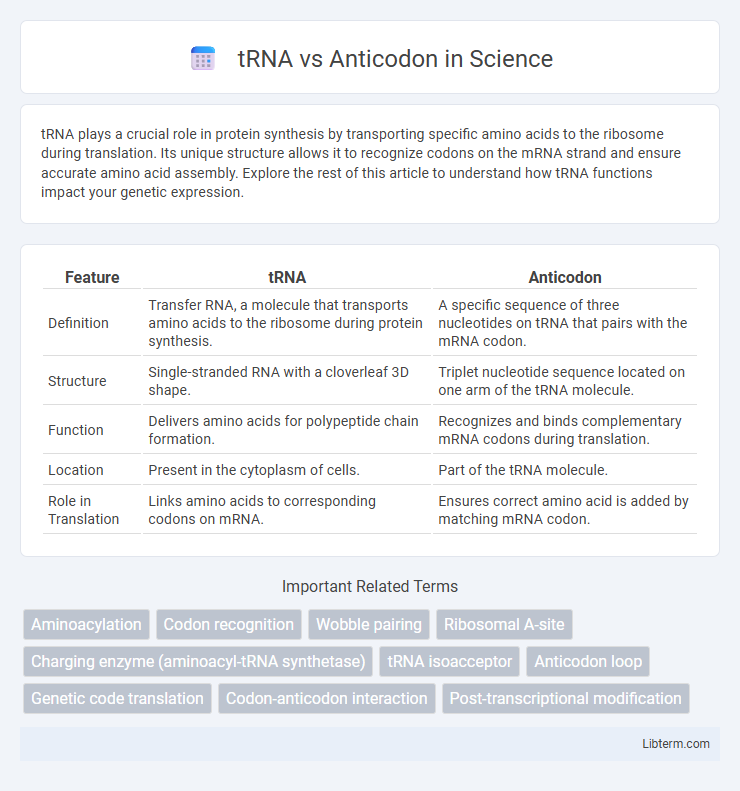tRNA plays a crucial role in protein synthesis by transporting specific amino acids to the ribosome during translation. Its unique structure allows it to recognize codons on the mRNA strand and ensure accurate amino acid assembly. Explore the rest of this article to understand how tRNA functions impact your genetic expression.
Table of Comparison
| Feature | tRNA | Anticodon |
|---|---|---|
| Definition | Transfer RNA, a molecule that transports amino acids to the ribosome during protein synthesis. | A specific sequence of three nucleotides on tRNA that pairs with the mRNA codon. |
| Structure | Single-stranded RNA with a cloverleaf 3D shape. | Triplet nucleotide sequence located on one arm of the tRNA molecule. |
| Function | Delivers amino acids for polypeptide chain formation. | Recognizes and binds complementary mRNA codons during translation. |
| Location | Present in the cytoplasm of cells. | Part of the tRNA molecule. |
| Role in Translation | Links amino acids to corresponding codons on mRNA. | Ensures correct amino acid is added by matching mRNA codon. |
Introduction to tRNA and Anticodon
Transfer RNA (tRNA) is a crucial adaptor molecule in protein synthesis that transports specific amino acids to the ribosome. The anticodon is a unique sequence of three nucleotides on the tRNA that pairs complementary to the mRNA codon, ensuring accurate translation of the genetic code. This precise matching between tRNA anticodon and mRNA codon is essential for synthesizing proteins according to the correct amino acid sequence.
Definition of tRNA
tRNA (transfer RNA) is a small RNA molecule that delivers specific amino acids to the ribosome during protein synthesis by recognizing codons on mRNA through its anticodon region. The anticodon is a sequence of three nucleotides on the tRNA that pairs complementarily with the corresponding mRNA codon, ensuring accurate translation. This interaction is crucial for assembling amino acid chains in the correct order, forming functional proteins.
What is an Anticodon?
An anticodon is a sequence of three nucleotides located on one end of a transfer RNA (tRNA) molecule that is complementary to a specific codon on messenger RNA (mRNA). This complementary base-pairing ensures accurate translation of genetic information during protein synthesis by matching each codon with the appropriate amino acid. The interaction between the anticodon and codon is essential for maintaining the fidelity of the genetic code in ribosomal translation.
Structural Features of tRNA
tRNA exhibits a distinctive cloverleaf structure consisting of the acceptor stem, D arm, anticodon arm, TPsC arm, and variable loop, enabling it to carry specific amino acids during protein synthesis. The anticodon loop contains a triplet nucleotide sequence, known as the anticodon, which base-pairs with complementary codons on mRNA to ensure accurate translation. This structural conformation of tRNA is crucial for its role in decoding the genetic information and facilitating precise amino acid incorporation into the growing polypeptide chain.
Localization and Role of Anticodons
tRNA molecules are primarily localized in the cytoplasm where they play a critical role in protein synthesis by delivering specific amino acids to the ribosome. The anticodon, a sequence of three nucleotides located on the tRNA, is responsible for recognizing and binding to the complementary codon on mRNA during translation. This precise codon-anticodon pairing ensures the incorporation of the correct amino acid into the growing polypeptide chain, directly influencing the accuracy of protein assembly.
tRNA Function in Protein Synthesis
tRNA functions as the key adaptor molecule in protein synthesis by transporting specific amino acids to the ribosome, where they are added to a growing polypeptide chain. Each tRNA contains an anticodon sequence that pairs complementary to the mRNA codon, ensuring accurate translation of genetic information. This codon-anticodon interaction facilitates the precise assembly of amino acids according to the mRNA template, essential for synthesizing functional proteins.
Anticodon-Codon Interaction Explained
The anticodon is a specific sequence of three nucleotides on the tRNA molecule that pairs complementarily with the codon on mRNA during protein synthesis. This anticodon-codon interaction ensures accurate translation of the genetic code by matching each tRNA to its corresponding amino acid and codon triplet. The precise hydrogen bonding between anticodon and codon stabilizes the mRNA-tRNA complex within the ribosome, facilitating correct amino acid incorporation into the growing polypeptide chain.
Differences Between tRNA and Anticodon
tRNA, or transfer RNA, is a molecule that transports specific amino acids to the ribosome during protein synthesis, whereas an anticodon is a sequence of three nucleotides on the tRNA that pairs with the complementary codon on mRNA. The tRNA has a cloverleaf structure with an amino acid attachment site, while the anticodon loop contains the anticodon triplet crucial for genetic code recognition. Unlike tRNA, which is a physical molecule, the anticodon is a functional segment within tRNA essential for decoding mRNA into amino acids.
Importance in Genetic Translation
tRNA plays a crucial role in genetic translation by transporting specific amino acids to the ribosome, determined by its anticodon sequence that pairs with complementary mRNA codons. The anticodon, a set of three nucleotides on the tRNA, ensures accurate decoding of the mRNA, maintaining the fidelity of protein synthesis. This precise interaction between tRNA anticodons and mRNA codons is essential for translating the genetic code into functional polypeptides.
Summary: tRNA vs Anticodon
tRNA (transfer RNA) is a crucial molecule in protein synthesis that delivers specific amino acids to the ribosome. The anticodon is a sequence of three nucleotides on the tRNA that pairs complementarily with the mRNA codon, ensuring accurate amino acid incorporation. This precise matching between tRNA anticodon and mRNA codon drives the translation process and protein assembly.
tRNA Infographic

 libterm.com
libterm.com